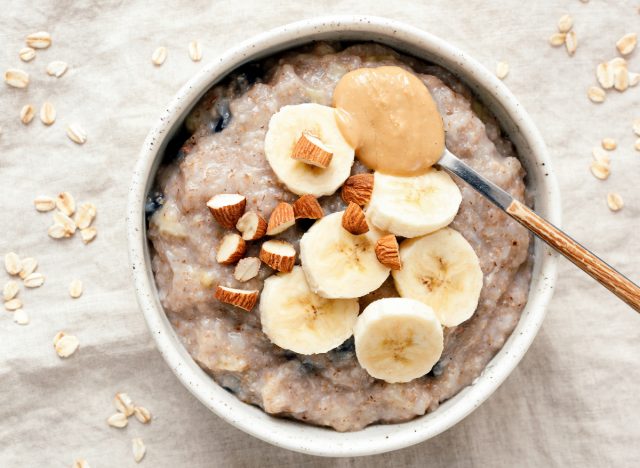Aging looks different for everyone. For some, reaching your 40s, 50s, 60s, and beyond means resigning yourself to a slower-paced life. For others, their golden years involve taking on new challenges, staying active, and continually growing and learning. However, common denominators of aging that everyone will experience are a loss of muscle mass (sarcopenia) and a decline in physical fitness. Fortunately, you can combat aging’s harmful effects on physical fitness through healthy lifestyle habits like diet and exercise. That’s where we come in with the 10 best foods to increase your physical fitness as you age.
We here at Eat This, Not That! asked nutrition expert Trista Best, RD, a registered dietitian with Balance One Supplements, to share wisdom on the best foods to eat for increasing your fitness and muscular endurance as you grow older. Including more nutritious foods in your diet will help keep your body in tip-top shape and functioning well into old age. Keep reading to find out what they are, then check out the 4 Worst Eating Mistakes When Your Goal Is To Build Muscle.


Quinoa is a nutrient-dense whole grain that’s gluten-free and high in protein and fiber, making it a fantastic option for building and maintaining muscle. According to the Harvard T.H. Chan School of Public Health, quinoa is also considered a “complete protein,” which means it features sufficient quantities of the nine essential amino acids, including the branched-chain amino acids (BCAAs) leucine, isoleucine, and valine, which are optimal for muscle growth.
“Adding quinoa to your regular diet as you age can simultaneously help lower your cholesterol and regular blood sugar as the fiber works to slow digestion and remove cholesterol from the body,” Best explains.


Eggs are an excellent source of protein, with one large egg providing over six grams. Eggs contain essential amino acids that are important for muscle repair and growth, according to a 2022 study published in The Journal of Nutrition.
Additionally, eggs are a rich source of choline—a critical nutrient for muscular health. “Choline is found in the whites of eggs and can help support muscle function and development,” says Best. “Choline is important for synthesizing acetylcholine, a neurotransmitter that plays a key role in muscle contraction.”


One of the healthiest fish you can eat, the protein and nutrients in salmon offer various health benefits, such as helping to promote muscle protein synthesis.
“Salmon is rich in omega-3 fatty acids, which have anti-inflammatory properties to help reduce muscle soreness and improve recovery,” states Best. “These anti-inflammatory properties can also help reduce the risk of age-related chronic diseases and improve overall health and well-being.”


“Sweet potatoes are a superb source of complex carbohydrates, which provide sustained energy for physical activity to help boost your workouts and keep you feeling full without a sugar crash,” says Best.
These delicious root vegetables are ideal for older adults due to their high fiber and nutrient content (There are six grams of fiber in one large sweet potato!) which can help support digestive health, boost immunity, and reduce the risk of chronic diseases, according to a review published in Nutrition Reviews.


Potatoes often get a bad rap as an unhealthy food high in carbs, reports USA Today. However, potatoes are a nutrient-dense source of complex carbs (18 grams per 100 grams of potato) that are ideal for fueling physical activity. In addition, a 2022 study published in Medicine and Science in Sports and Exercise found that eating more potatoes can enhance muscle protein synthesis and promote recovery from exercise.
READ RELATED: 7 Surprising Habits That Can Cause Serious Damage to Your Body


Blueberries are a superfood packed with essential nutrients for healthy aging, like antioxidants, fiber, and vitamin C. Moderate blueberry intake has been associated with decreased risk of cardiovascular disease, death, and type 2 diabetes, along with enhanced weight maintenance and brain health, according to a study published in Advances in Nutrition.
“Blueberries are a rich source of antioxidants, which can help reduce inflammation and improve workout recovery. The aging adult can benefit from adding them to their diet to protect against oxidative stress and chronic disease,” says Best.


Eating a handful of these nutritious nuts daily is a surefire way to help support healthy aging. The fiber, vitamins, minerals, heart-healthy fats, and other essential nutrients in almonds offer anti-inflammatory and lipid-lowering benefits, says a 2021 study in Nutrients. In addition, just half a cup of almonds provides over 15 grams of high-quality protein.
“Almonds are a good source of protein and healthy fats, making them a great option for a pre or post-workout snack. Almonds also support brain, bone, and heart health for healthy aging,” says Best.


According to the BBC, leafy green vegetables like spinach are among the most nutritious foods on the planet.
“Spinach is a nutrient-dense leafy green high in iron, which is important for delivering oxygen to muscles during exercise,” explains Best. “Spinach is good for aging adults due to its high iron content, which can help support cognitive function and energy levels, as well as its anti-inflammatory properties that may reduce the risk of age-related chronic diseases.”


“Chicken is a good source of lean protein, which is essential for muscle repair and growth,” says Best. “The high protein content of chicken can help the aging adult maintain muscle mass, support immune function, and reduce the risk of heart disease due to its low saturated fat content.”


A natural superfood, oatmeal is one of the best foods to increase your physical fitness as you grow older. It’s loaded with nutritional value to aid your fitness goals and support muscular endurance as you age.
“Oatmeal is a complex carbohydrate that provides sustained energy for physical activity and is also high in fiber, which can help regulate blood sugar levels. Oatmeal’s fiber is also good for aging adults as it helps digestive health and cognitive function,” says Best.
Source:










